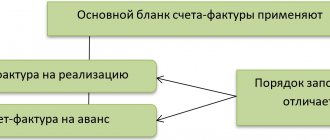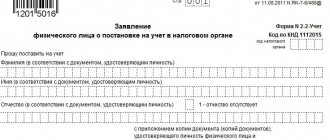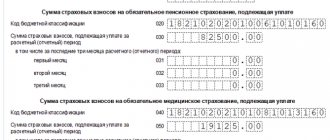Detailed instructions for filling out invoices can be found in Decree of the Government of the Russian Federation of December 26, 2011 No. 1137 “On the forms and rules for filling out (maintaining) documents used in calculations of value added tax.” In general, filling out an invoice for an advance payment is not much different from the document issued during the shipment of goods (provision of services, performance of work).
Line 1 indicates the number and date. Advance invoices are numbered in normal chronological order. There are no special rules for numbering documents for advance payments (letter of the Ministry of Finance of Russia dated October 26, 2012 No. 03-07-11/427). Please note: if a company needs to introduce special numbering for such documents, then legislation does not prohibit this. To make it easier to identify such papers, you can add a letter designation to the number. For example, No. A-315 or No. 315AB, etc. There is no liability for violation of the numbering of invoices.
In case of advance payment, the document must be dated no later than five calendar days from the date of receipt of the advance payment amount (clause 3 of Article 168 of the Tax Code of the Russian Federation). If the last day of the period falls on a weekend or holiday, then the invoice must be issued no later than the next business day (Clause 7, Article 6.1 of the Tax Code of the Russian Federation).
In lines 3 and 4, the name of the shipper, consignee and their addresses are not indicated (letter of the Ministry of Finance of Russia dated December 19, 2020 No. 03-07-05/84934).
In line 5 you need to indicate the date and number of the payment document on the basis of which the prepayment was received. This could be a money order or a cashier's check. If the advance was received by several payment documents, then all of them can be listed in one invoice, subject to the five-day issuance period (letter of the Ministry of Finance of Russia dated March 28, 2007 No. 03-02-07/1-140). In the case of a non-cash form of payment, for example, if a bill of exchange was received as an advance payment, a dash is placed in this column.
In what case is it necessary to issue an invoice for an advance payment?
Such paper should be exhibited in two situations:
- When goods are shipped, that is, certain rights, services or work are transferred from hand to hand.
- When the buyer transfers an advance in accordance with paragraph 3 of Article 168 of the Tax Code of the Russian Federation.
As mentioned above, the procedure for issuing an invoice should not exceed 5 days. The paper must contain certain details, clearly stated in paragraphs 5 and 5.1 of Article 169 of the Tax Code of the Russian Federation (you can find out more about what an advance invoice is and why it is needed here).
Important! There are cases when payments are transferred to the accounts of some company for continuous supplies. In such a situation, it is allowed to issue the document in question at the end of the estimated period of time, for example, a quarter.
In this case, the invoice must be issued for the amount of all payments received from the customer, minus the price of services provided in fact.
All this is clearly stated in letter No. 03-07-15/39 , which was given by the Ministry of Finance. Thus, the legislation clearly controls such operations and the issuance of the mentioned document.
We talked more about in what cases and when an advance invoice is issued and what the deadlines for its issuance are in a separate article.
When is ASF not required?
The paper in question is not always issued. There are situations when this is not required. An invoice should not be drawn up if the advance payment is fully provided for future deliveries of products , performance of certain works or provision of services. Wherein:
- The production cycle during which manufacturing is carried out must last more than six months.
- Taxation is carried out at a rate of 0%.
- There should be no taxation at all.
All the points listed above are clearly stated in paragraph 3 of paragraph No. 17 of the Rules, which were approved by Decree of the Government of the Russian Federation No. 1137. It is worth mentioning that the Ministry of Finance provided an explanation containing confirmation that issuing such an invoice is not required if the products were shipped within 5 calendar days from the date of receipt of the full advance payment for this shipment.
Based on all that has been said, we can conclude that the issuance of such a document has not undergone significant changes compared to last year. The deadlines for submitting this paper to yourself and third parties remained the same, and the procedure itself did not become more complicated, rather the opposite. Confirmation of this can be seen in letter No. 03-07-14/65759, issued by the Ministry of Finance on November 10, 2020.
Accounting and numbering
An advance invoice is a regular invoice, but with certain conditions (prepayment). Accordingly, the question of its numbering arises very often. The law (Government Decree No. 1137) states that the chronological order is the same for all invoices. This means that the advance invoice is numbered in the general order.
Some accountants keep separate records, which is not entirely true. Although there is no liability for this, for consolidation during checks, the correct sequence makes things easier. For convenience, you can put notes in the form of letter values (101/AB).
Video: how to issue and process advance invoices
Filling out an advance invoice is not difficult. In order for the written document to be accepted for credit, you must be careful and avoid common mistakes. Records should be kept in a log book, as required by law, failure to comply with which may result in fines.
- Author: Sergey Saltykov
My name is Sergey. I have completed higher education in management. I am 24 years old, I started writing articles while still a student. Freelancing for more than three years. I am ready to carry out orders on various topics, as I love to develop. Rate this article:
- 5
- 4
- 3
- 2
- 1
(1 vote, average: 5 out of 5)
Share with your friends!
What deadlines must be met?
As mentioned above, the Tax Code of the Russian Federation, namely in paragraph 3 of Article 168, clearly states the period for issuing an invoice for an advance payment, which is 5 calendar days from the moment when:
- Payment is received in part or in full. Thus, payment is made for work performed, services provided, the purchase of a batch of products, or the vesting of the buyer with rights to certain property.
- The delivery of a consignment of goods, the provision of services in full, and the vesting of the person who paid the money with rights to the property involved in the transaction are carried out.
It is worth noting that the period of 5 calendar days begins to count from the day following the day on which products were issued, services were provided or work was performed.
Even Article 6.1 of the Tax Code of the Russian Federation clearly states that if the last day of the designated period falls on a weekend or holiday, then the end of the established period is postponed to the next working day.
Important! There is an option when the seller issues such a document once for all goods sold at the end of the month.
However, it is worth remembering that such an opportunity is given only to organizations that work in areas that regularly and without interruption deliveries to one counterparty. Enterprises that do not comply with such conditions will have to adhere to standard rules.
What is the penalty for violations?
If such a violation is discovered during an audit, when it is no longer possible to submit clarifications to the declaration and issue a corrected invoice, taxpayers can only bite their elbows. After all, it would seem that the advance payment is still repaid by shipment in the tax period - but not everything is so simple.
Subscribe to our newsletter
Yandex.Zen VKontakte Telegram
If the inspector discovers that an invoice was not issued for the advance payment received, he simply charges additional VAT. And so - for all advances for the tax period. But now the taxpayer cannot exercise the right to deduction, since he did not present it (such VAT deductions are not declared in the declaration).
In addition, the tax office will also fine the taxpayer for a gross violation of the rules for accounting for taxable items under Art. 120 NK. For such an offense a fine of 10 thousand rubles is imposed if the offense occurred in one reporting period. And if such violations occurred more often, the fine increases to 30 thousand rubles.
Compilation rules
It is worth remembering that the above-mentioned paragraph 5.1 of Article 169 of the Tax Code of the Russian Federation states that such paper must contain certain details , namely:
- The serial number of the document, the date when it was issued (we talked in detail about what the serial number of an invoice is and how to use indexes and prefixes here).
- Name, address, TIN of the seller and buyer.
- Number of the paper that performs payment and settlement functions.
- Total prepayment amount.
- Tax rate.
- A clear name of the supplied products, transferred rights to property or a description of the work performed, services provided.
- The total amount of tax, which is calculated taking into account the applicable tax rate.
If errors are made when drawing up the document in question, the seller will suffer virtually no harm. However, such careless attitude towards important documentation will undoubtedly leave a bad mark on his reputation. The fact is that due to such errors, the buyer loses the opportunity to deduct VAT.
Thus, trust in the seller will steadily decline with each new error in the design, entailing a violation of the rules for issuing invoices. He will lose clients, and with them a lot of money, which no one will return in the future.
Accounting for taxable and non-taxable VAT transactions by the buyer
VAT on goods, works and services that are used to carry out activities both subject to and non-taxable to VAT must be accounted for separately . Paragraph 4 of Article 170 , which establishes this rule, is silent about the need to apply this approach in relation to prepayment, which is transferred towards the supply of such goods. Thus, the prepayment in this case is recorded in the purchase ledger as a total amount. Also, all of it can be claimed as a deduction.
When the goods for which the advance payment was transferred are received, the VAT accepted for deduction should be restored. It must then be accounted for separately. The part that corresponds to transactions subject to VAT is accepted for deduction. The remaining tax amount is written off to increase the cost of the goods.
In conclusion, let us mention one more circumstance. Accountants often make errors in deductions on advance invoices when selectively approaching their application. If you always declare (or do not declare) the deduction of VAT on prepayments, then the process has been worked out to the point of automaticity. If you use a selective approach, then each time you receive a shipping invoice you should check whether VAT has been deducted from the corresponding advance. Otherwise, it’s easy to miss the errors, and your VAT return will not pass the automatic check of the Federal Tax Service.
How to fill out the document?
The details that were described above must be correctly entered into the invoice, taking into account some features, namely:
- The serial number and date of discharge in accordance with RF PP No. 451 must be indicated in the first line of the document.
- As for the name, address and TIN of the seller and buyer, they must be indicated as specified in paragraph 3 of Article 1473 of the Civil Code of the Russian Federation. It states that a legal entity must have a full or abbreviated name of the company. Such information should be written in the second line.
- The name of the paper that performs payment and settlement functions should occupy the fifth line, when filling out which you need to pay attention to clause 2 of RF Regulation No. 451.
- The prepayment amount should occupy the eighth line. If received, it must be designated as prescribed in paragraph 4 of Article 164 of the Tax Code of the Russian Federation, namely by the method of calculation.
Important! From what is written above, it is clear that the preparation of invoices is regulated not only by the Ministry of Finance, but also by Civil and Tax laws.
For this reason, making mistakes when compiling this may result in a violation of the laws of Russia and, as a result, serious punishment. As a rule, those who make mistakes in drafting are fined various amounts. The more serious the violation, the greater the fine.
How to apply and sample
The invoice has the form established by law, which consists of a header and a tabular part, with fields to fill out.
Each organization has the right to slightly modify the form for its own convenience, the main thing is that all required details are preserved.
A form is possible.
Filling out the form begins with the title part, in which the following data is indicated line by line:
| Line no. | Content |
| 1 | Number in order, according to registration data, and the date when the s/f was issued |
| 1a | If a correction is submitted, the number and date of the correction is indicated. |
| 2 | Name of supplier organization |
| 2a | Seller's registration address |
| 2b | Checkpoint and TIN of the seller |
| 3 | Information about the shipper is not recorded when registering an advance payment slip. |
| 4 | Information about the consignee is not recorded when issuing an advance payment |
| 5 | Date and number of the document on the basis of which VAT is calculated |
| 6 | Customer name |
| 6a | Customer address |
| 6b | Checkpoint and TIN of the customer |
| 7 | Name of the currency in which payment is made, code assigned to it |
| 8 | If necessary, indicate the data of the state contract |
After filling out the top part of the document, you can proceed to designing the table. Each column has a name and number, which makes it easy to fill out:
| Column No. | Content |
| 1 | The full name of the product or service, when issuing a document for an advance, the wording “Advance on account of ...” is written down, then it is indicated what exactly the advance payment was made for, as well as the number and date of the agreement on the basis of which this operation is carried out |
| 1a | Code for the type of product, not indicated when paying an advance |
| 2 | Code of units used to measure goods; when making an advance payment, the field remains empty |
| 2a | Conventional abbreviated designation of units of measurement, not indicated in the advance payment document |
| 3 | Quantity not stated in the advance payment document |
| 4 | The price determined per unit of goods is not written in the advance payment form |
| 5 | The total cost of the entire quantity of goods, excluding VAT, is not indicated when paying an advance |
| 6 | The amount of excise tax, including when paying an advance, is not indicated |
| 7 | VAT rate |
| 8 | The amount of VAT on the cost of goods subject to payment to the budget |
| 9 | Total cost of all goods, including VAT |
| 10 | The code assigned to the country of origin of the goods is not indicated in the advance payment form. |
| 10a | The name of the country of origin is not indicated in the advance payment contract |
| 11 | The customs declaration number is not indicated when making an advance payment |
Below all the columns is the line “Total payable”, in it you need to calculate the total amount of tax (add all the values in column 8), and also indicate the total cost of goods, including tax (add all the values in column 9).
After the table below, the document contains a field in which signatures with transcripts and indications of positions, management of the organization and chief accountant are located. If authorized, other responsible persons may sign instead of the indicated persons. Stamps are also placed in this field.
The invoice is drawn up in two copies, the first of which is kept by the supplier, and the second is given to the customer.
Sample:
What to do after?
Once the document in question has been correctly displayed, you can begin registering it in the sales book . Sellers paying VAT must carry out this procedure.
It is also possible to register this paper in the journal of invoices that were received and issued (we talked in detail about what needs to be done after receiving an invoice for an advance payment from a supplier and what are the rules for registering ASF in this article). However, this procedure can only be carried out by intermediaries acting on their own behalf, but in the interests of third parties, that is, their customers. Usually these are commission agents or agents acting in accordance with paragraph 1 of Art. 990 and paragraph 1 of Art. 1005 of the Civil Code of the Russian Federation.
It is worth mentioning that the forms of such documents as the book of sales, purchases and accounting journal, as well as the rules according to which they are filled out, are approved by the above-mentioned RF PP No. 1137.
Do not forget that the simplicity and speed of the registration procedure directly depends on the correct completion and execution of the invoice. If there are shortcomings in it, then delays, problems and all kinds of difficulties are inevitable.
The document in question can in fact be drawn up and registered relatively quickly if you adhere to all points of legislation regulating these procedures and follow the basic rules established by the Ministry of Finance of the Russian Federation. If the seller treats such paper responsibly, then he, without any doubt, will earn the respect of his clients and increase his income several times.
Filling out sales and purchase books by the supplier
The supplier registers the advance invoice in the sales book with transaction type code 02 . This must be done in the same period in which the prepayment was received. Column 11 indicates the payment number, and columns 4-6, 14-16 and 19 remain blank.
Within 5 days after shipment, a shipping invoice is recorded in the sales book. In this case, in column 11, the payment for the advance payment is indicated as a document confirming payment.
At the same time, the previously issued advance invoice must be reflected in the purchase book with transaction code 22. In column 7, information from the same payment document for which the advance was received should be indicated.
Which transactions correspond to the issued document?
When an advance payment is received, a transaction is generated that records the funds received in the account of the service provider (seller). Then, after the advance invoice is prepared by the seller and received by the buyer, the completed invoices are posted when they are registered.
This can be done either on an individual account basis or in a generally automated manner (as explained earlier).
The seller's wiring will be something like this:
- debit 51 Credit 62ав – advance money received from the buyer;
- debit 62av. Credit 68 – the accrual of added tax, which is allocated from the advance payment, is noted;
- debit 62 Credit 90.1 – income from the sale of inventory and materials is noted in the advance account;
- debit 90.3 Credit 68 – VAT is charged on the sales transaction;
- debit 68 Credit 62av. – advance VAT is accepted for deduction;
- debit 62av. Credit 62 rub. – prepaid money is counted.
And in accounting:
Deb. 60 av. Credit. 51 – receiving an advance.- Deb. 68 Cred. 60 Av – tax on prepayment is deductible.
- Deb. 19 Cred. 60 rubles – tax is allocated according to the goods and materials received.
- Deb. 68 Cred. 19 – income tax is accepted as a deduction.
- Deb. 60 av Cred. 68 – advance VAT restored.
- Deb. 60 RUR Credit. 60 Av – advance payment is counted.
As can be seen from the content of this article, the use of electronic programs for registering various accounts (including advance accounts) is preferable. It allows you to store all the necessary information in one place, and due to the interconnectedness of documents, the possibility of making errors in them is minimal.
In addition, mass automatic filling of documents allows you to significantly save working time.
Registration options
When registering an account in the 1C program, there are several ways to register it.
- Always register when receiving an advance. If you select this option, all advance invoices received will be recorded automatically for each accrued amount, with the exception of advances that were offset on the day of receipt.
- Do not register credits within 5 days. In this case, invoices will be created only for those amounts that were not credited within five days from the date of receipt. This method helps to implement the requirement in the Tax Code to register accounts within 5 days (Article 168).
- Amounts credited before the end of the month are not recorded. This registration option is not suitable for all cases (otherwise you may receive a fine for late registration).
You need to choose it only in situations where the supply of goods or services occurs continuously in relation to the same person.It is suitable for advance payment for Internet access, communication, electricity services, as well as in other similar situations.
The fact that such a practice is not a violation was clarified in a letter from the Ministry of Finance dated March 6, 2009. In this case, invoices of this kind must be issued no later than the 5th day of the month following the month of transfer of the advance.
For example, the services of an Internet provider were paid in advance for July. In such a situation, the advance invoice will need to be issued no later than July 5 of the same year.
- Do not register accounts offset until the end of the tax period. The use of this clause is quite controversial and may cause disagreements with the tax authorities. It should be used only by those companies that are ready to defend their position.
The ability to choose this option is due to the following: there is an opinion that the name “advance payment” should not apply to payments accrued in the same period in which the shipment occurs, since then they do not correspond to the very concept of “advance payment”.And if so, then there is no need to prepare advance accounts for the current period. However, it should be said once again that if you choose this option, disputes with the tax service will be ensured.
- Do not register incoming payments as advance payments at all. It is suitable only for organizations designated in the Tax Code in Article 167. These include companies with a long production cycle of final products exceeding 6 months.
Example
The seller received an advance in the amount of 59 thousand rubles. (VAT – 9 thousand rubles). The first shipment was worth 50 thousand rubles. The same amount is displayed in column 9 of the account. But when registering a document, column 15 indicates the full amount of the advance (RUB 59 thousand), and column 16 indicates VAT deductible (RUB 7,627.12). When shipping the next batch for 9 thousand rubles. in column 15 the entire amount of the advance is again indicated (59 thousand rubles), and in column 16 - 1372.88 rubles. VAT.










